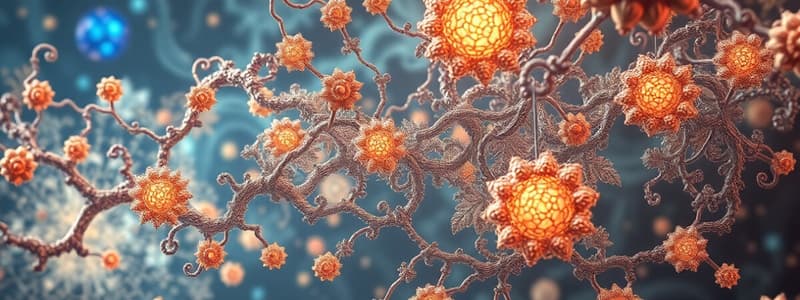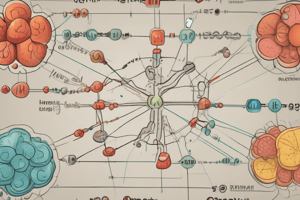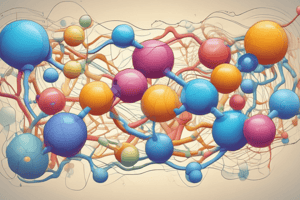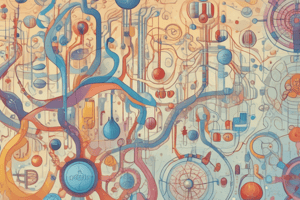Podcast
Questions and Answers
During glycolysis, which of the following conversions is catalyzed by triose phosphate isomerase?
During glycolysis, which of the following conversions is catalyzed by triose phosphate isomerase?
- Fructose 1,6-bisphosphate to glyceraldehyde 3-phosphate
- 1,3-bisphosphoglycerate to 3-phosphoglycerate
- Glyceraldehyde 3-phosphate to 1,3-bisphosphoglycerate
- Dihydroxyacetone phosphate (DHAP) to glyceraldehyde 3-phosphate (correct)
Which of the following best describes the role of glyceraldehyde-3-phosphate dehydrogenase (GAPDH) in glycolysis?
Which of the following best describes the role of glyceraldehyde-3-phosphate dehydrogenase (GAPDH) in glycolysis?
- Hydrolyzes 1,3-bisphosphoglycerate to form 3-phosphoglycerate and ATP.
- Catalyzes the transfer of a phosphate group from ATP to glyceraldehyde-3-phosphate.
- Oxidizes and phosphorylates glyceraldehyde-3-phosphate to form 1,3-bisphosphoglycerate, generating NADH. (correct)
- Facilitates the isomerization of dihydroxyacetone phosphate to glyceraldehyde-3-phosphate.
In glycolysis, the conversion of 1,3-bisphosphoglycerate to 3-phosphoglycerate is coupled with:
In glycolysis, the conversion of 1,3-bisphosphoglycerate to 3-phosphoglycerate is coupled with:
- The release of carbon dioxide.
- The reduction of NAD+ to NADH.
- The oxidation of NADH to NAD+.
- The phosphorylation of ADP to ATP. (correct)
Which enzyme catalyzes the conversion of 3-phosphoglycerate to 2-phosphoglycerate during glycolysis?
Which enzyme catalyzes the conversion of 3-phosphoglycerate to 2-phosphoglycerate during glycolysis?
During glycolysis, enolase catalyzes which of the following reactions?
During glycolysis, enolase catalyzes which of the following reactions?
Which of the following steps in glycolysis directly generates ATP through substrate-level phosphorylation?
Which of the following steps in glycolysis directly generates ATP through substrate-level phosphorylation?
What is the net ATP production from one molecule of glucose that undergoes glycolysis?
What is the net ATP production from one molecule of glucose that undergoes glycolysis?
What is the role of 2,3-bisphosphoglycerate (2,3-BPG) in red blood cells?
What is the role of 2,3-bisphosphoglycerate (2,3-BPG) in red blood cells?
Under anaerobic conditions, what is the primary fate of pyruvate in human cells?
Under anaerobic conditions, what is the primary fate of pyruvate in human cells?
If a yeast culture is grown anaerobically, which of the following is the primary end product of glucose metabolism?
If a yeast culture is grown anaerobically, which of the following is the primary end product of glucose metabolism?
Which enzyme is responsible for catalyzing the conversion of pyruvate to lactate during anaerobic conditions?
Which enzyme is responsible for catalyzing the conversion of pyruvate to lactate during anaerobic conditions?
What is the primary purpose of converting pyruvate to lactate under anaerobic conditions?
What is the primary purpose of converting pyruvate to lactate under anaerobic conditions?
Which of the following conditions leads to increased lactate production?
Which of the following conditions leads to increased lactate production?
Lactic acidosis is characterized by:
Lactic acidosis is characterized by:
Which of the following is a common cause of lactic acidosis?
Which of the following is a common cause of lactic acidosis?
Alcohol intoxication can contribute to lactic acidosis by:
Alcohol intoxication can contribute to lactic acidosis by:
Which of the following enzymes, when inhibited, can contribute to lactic acidosis?
Which of the following enzymes, when inhibited, can contribute to lactic acidosis?
Why do red blood cells (RBCs) depend on glycolysis for energy production?
Why do red blood cells (RBCs) depend on glycolysis for energy production?
How does hypoxia contribute to increased lactate production?
How does hypoxia contribute to increased lactate production?
In the context of glycolysis, which statement accurately describes irreversible steps?
In the context of glycolysis, which statement accurately describes irreversible steps?
Flashcards
Step 5 of Glycolysis
Step 5 of Glycolysis
DHAP is converted to GAP by triose phosphate isomerase, ensuring both molecules are in the same form. This results in two molecules of GAP.
Step 6 of Glycolysis
Step 6 of Glycolysis
GAP is oxidized (and phosphorylated) to 1,3-bisphosphoglycerate (1,3-BPG) by glyceraldehyde-3-phosphate dehydrogenase (GAPDH). This reaction also generates NADH.
Step 7 of Glycolysis
Step 7 of Glycolysis
1,3-BPG is converted to 3-phosphoglycerate (3-PG) by glycerate kinase (GK), generating ATP via substrate-level phosphorylation. This step directly produces ATP from ADP.
Step 8 of Glycolysis
Step 8 of Glycolysis
Signup and view all the flashcards
Step 9 of Glycolysis
Step 9 of Glycolysis
Signup and view all the flashcards
Step 10 of Glycolysis
Step 10 of Glycolysis
Signup and view all the flashcards
Pyruvate fates
Pyruvate fates
Signup and view all the flashcards
Pyruvate becomes Lactate
Pyruvate becomes Lactate
Signup and view all the flashcards
Lactic Acidosis
Lactic Acidosis
Signup and view all the flashcards
Synthesis of 2,3 bisphosphoglycerate in RBC function
Synthesis of 2,3 bisphosphoglycerate in RBC function
Signup and view all the flashcards
Pyruvate conversion
Pyruvate conversion
Signup and view all the flashcards
When is Lactate Produced
When is Lactate Produced
Signup and view all the flashcards
Cause of metabolic acidosis
Cause of metabolic acidosis
Signup and view all the flashcards
What is a very common cause for lactic acidosis?
What is a very common cause for lactic acidosis?
Signup and view all the flashcards
Other reasons that lead to Lactic Acidosis.
Other reasons that lead to Lactic Acidosis.
Signup and view all the flashcards
Study Notes
Step 5: Isomerization
- Dihydroxyacetone phosphate (DHAP) converts to glyceraldehyde-3-phosphate (GAP) via triose phosphate isomerase.
- This ensures both molecules are in the same form.
- This results in two molecules of GAP.
- It is a reversible step, preferring the forward direction due to equilibrium.
Step 6: Oxidation-Reduction
- Glyceraldehyde 3-phosphate (GAP) is oxidized and phosphorylated to 1,3-bisphosphoglycerate (1,3-BPG) with glyceraldehyde-3-phosphate dehydrogenase (GAPDH).
- This generates NADH capturing energy in the form of reducing equivalents.
- The source of Pi (inorganic phosphate) is free, not from ATP because the reaction has a negative change in Gibbs free energy.
- This step is reversible.
Step 7: Phosphorylation
- 1,3-BPG is converted to 3-phosphoglycerate (3-PG) by glycerate kinase (GK).
- ATP is generated through substrate-level phosphorylation.
- Step is reversible.
Steps 8-10
- Steps 1, 3, and 10 are the irreversible steps, and Kinases are used.
- Includes hexokinase, phospho frucho kinase and pyruvate kinase.
Step 8: Phosphoryl-Shift Isomerization
- 3-PG is isomerized to 2-phosphoglycerate (2-PG), by phosphoglycerate mutase, which involves transferring a phosphate group.
- The phosphate group is moved from carbon 3 to carbon 2.
- Reversible Step.
Step 9: Dehydration
- 2-PG loses water to form phosphoenolpyruvate (PEP), catalyzed by enolase.
- Phosphorus is on carbon 2
- Reversible Step
Step 10: Phosphorylation
- PEP is converted to pyruvate by pyruvate kinase (PK), which generates ATP via substrate-level phosphorylation
- A final step producing ATP and pyruvate, a crucial intermediate in various metabolic pathways
- The last irreversible step in the pathways
Energy Needs and Production in Glycolysis
- Glucose to Glucose 6-Phosphate requires -1 ATP
- Fructose 6-Phosphate to Fructose 1,6-bisphosphate requires -1 ATP
- Glyceraldehyde 3-Phosphate to 1,3-bisphosphoglycerate yields 2 NADH
- 1,3-bisphosphoglycerate to 3-Phosphoglycerate yields 2 ATP
- Phosphoenolpyruvate to Pyruvate yields 2 ATP
- NET: 2 ATP AND 2 NADH
Other Information
- The net ATP production in glycolysis is 2 because NADH produced in the cytoplasm may not enter the mitochondria for further energy production
- NADH in glycolysis is not an energy molecule, but an electron carrier, playing a role in redox reactions.
Synthesis of 2,3-Bisphosphoglycerate in Red Blood Cells
- An alternate pathway in red blood cells from 1,3-bisphosphoglycerate to 3-phosphoglycerate.
- Oxygen delivery to tissues is increased by binding to deoxyhemoglobin, decreasing its affinity for O2 and increasing O2 release.
- It doesn't need oxygen and happens in the cytoplasm in RBCs.
- RBCs depend on glycolysis.
- Net ATP production is zero in this case.
- The molecule, 2,3-BPG, binds to hemoglobin reducing the affinity of hemoglobin to rebind oxygen.
Fates of Pyruvate
- Pyruvate loses one carbon to become acetyl CoA and enter the Krebs cycle
- Pyruvate can gain CO2 to become oxaloacetate to supply the tricarboxylic acid cycle or create amino acids as aspartate
- Under anaerobic conditions, pyruvate can be converted to lactate
- In non-human cells (yeast), pyruvate can be converted into acetaldehyde then ethanol.
Pyruvate to Ethanol
- The conversion of pyruvate to ethanol happens in yeast.
- The decarboxylation of pyruvate removes CO2 and becomes acetaldehyde, reduced to ethanol by alcohol dehydrogenase (NADH is oxidized).
- CO2 diffuses away, which makes food fluffy during baking.
Pyruvate to Lactate
- Occurs under anaerobic conditions
- Pyruvate is reduced to lactate by accepting a proton.
- The carbonyl (ketone) converts to hydroxyl (secondary alcohol), using NADH as a coenzyme and the enzyme lactate dehydrogenase.
- The enzyme can reconvert lactate to pyruvate; it works in both directions.
- NADH and NAD+ alternate.
- The point of the forward reaction is to regenerate NAD+ to use it again.
When is Lactate Produced?
- In cells with low energy demand
- In rigorously exercising muscle needing increased energy, lactate level is increased 5 to 10 folds
- During Hypoxia to survive brief episodes of hypoxia
Clinical Hint: Lactic Acidosis
- Lactic acidosis is when there is an increase of plasma acidity
- Increased production or decreased utilization of lactic acid
- The most common cause is the impairment of oxidative metabolism due to collapse of the circulatory system.
- Also, due to impaired O2 transport, respiratory failure, or uncontrolled hemorrhage.
- Causes: Direct inhibition of oxidative phosphorylation, hypoxia in any tissue, alcohol intoxication with high NADH/NAD+
- Decreased gluconeogenesis, pyruvate dehydrogenase, TCA cycle activity or pyruvate carboxylase.
Studying That Suits You
Use AI to generate personalized quizzes and flashcards to suit your learning preferences.




